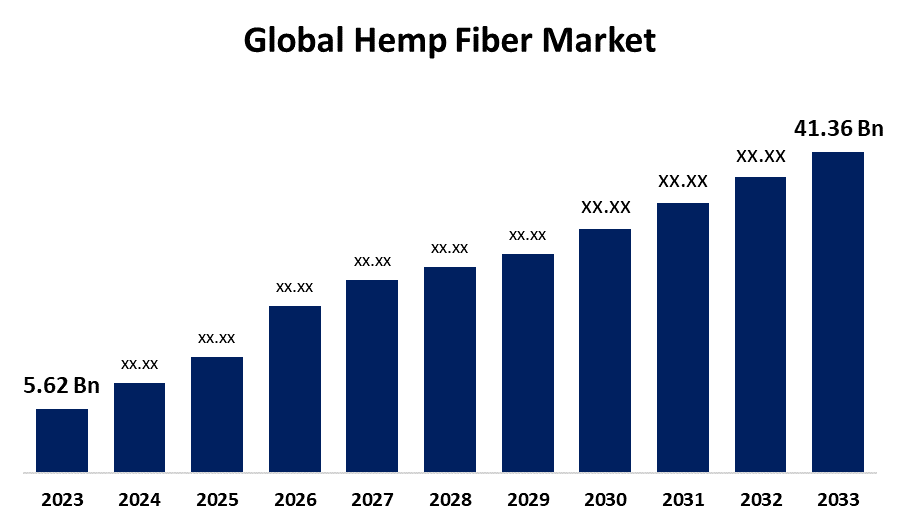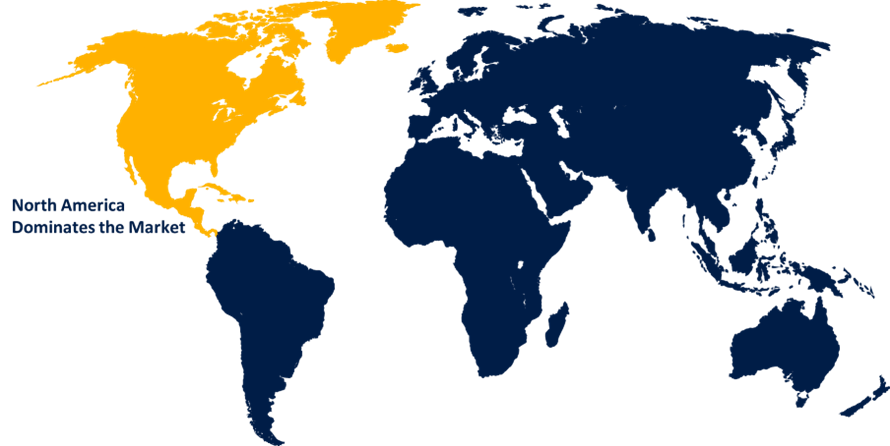Global Hemp Fiber Market Size, Share, and COVID-19 Impact Analysis, By Source (Conventional, Organic), By Application (Textiles, Paper Manufacturing, Automotive, Construction, Biodegradable Plastics, Others), and By Region (North America, Europe, Asia-Pacific, Latin America, Middle East, and Africa), Analysis and Forecast 2023 – 2033
Industry: Chemicals & MaterialsGlobal Hemp Fiber Market Insights Forecasts to 2033
- The Global Hemp Fiber Market Size was Valued at USD 5.62 Billion in 2023
- The Market Size is Growing at a CAGR of 22.09% from 2023 to 2033
- The Worldwide Hemp Fiber Market Size is Expected to Reach USD 41.36 Billion by 2033
- Asia Pacific is Expected to Grow the fastest during the forecast period.

Get more details on this report -
The Global Hemp Fiber Market Size is Anticipated to Exceed USD 41.36 Billion by 2033, Growing at a CAGR of 22.09% from 2023 to 2033.
Market Overview
Hemp fibre has grown as a highly versatile and sustainable material derived from hemp stalks. Its popularity has soared in recent years, because of its environmentally beneficial properties and diverse applications. The demand for sustainable products, combined with a greater understanding of hemp's numerous benefits, has propelled the hemp fibre market. Because of its adaptability, hemp fibre has gained popularity in industries such as textiles, automotive, and construction. Hemp fabric is very popular for towels because of its great absorbency and durability. Hemp fabric, on the other hand, is an excellent material for blankets and duvets due to its exceptional resilience. There are significant customers for product invention and development to broaden hemp fibre usage. R&D efforts are aimed at creating new hemp-based foods and beverages, textiles, and industrial intermediate materials. For example, hemp biomass can be used to refine and produce fuels, chemicals, and bioenergy. Hemp seeds have the potential to be used in meat and dairy replacements. Such product development, together with technical developments, will result in new and inventive applications, propelling the industry forward.
Report Coverage
This research report categorizes the market for the global hemp fiber market based on various segments and regions forecasts revenue growth and analyzes trends in each submarket. The report analyses the key growth drivers, opportunities, and challenges influencing the global hemp fiber market. Recent market developments and competitive strategies such as expansion, product launch, and development, partnership, merger, and acquisition have been included to draw the competitive landscape in the market. The report strategically identifies and profiles the key market players and analyses their core competencies in each sub-segment of the global hemp fiber market.
Global Hemp Fiber Market Report Coverage
| Report Coverage | Details |
|---|---|
| Base Year: | 2023 |
| Market Size in 2023: | USD 5.62 Billion |
| Forecast Period: | 2023-2033 |
| Forecast Period CAGR 2023-2033 : | 22.09% |
| 2033 Value Projection: | USD 41.36 Billion |
| Historical Data for: | 2019-2022 |
| No. of Pages: | 200 |
| Tables, Charts & Figures: | 110 |
| Segments covered: | By Source, By Application, By Region |
| Companies covered:: | Ecofibre Ltd., EnviroTextiles LLC, Canvaloop, Cone Denim LLC, Panda Biotech, LLC, Shanxi Greenland Textile Co. Ltd., Tiger Fiber, TOYOSHIMA & Co., Ltd., Delta Agriculture, Dun Agro Hemp Group, Konoplex LLC, and Others Key Vendors |
| Pitfalls & Challenges: | Covid-19 Empact, Challenges, Growth, Analysis. |
Get more details on this report -
Driving Factors
The growing global need for sustainable materials is a primary driver of the hemp fiber market. In an era when consumers and businesses both are actively exploring replacements to traditional, non-renewable resources, hemp fiber has emerged as a viable option. With its eco-friendly and biodegradable qualities, hemp fiber is an appealing option for people trying to lessen their environmental effect. Hemp fiber's adaptability has led to uses in a variety of industries, including textiles, construction, and automobiles. As consumers grow more aware of the importance of sustainable options, demand for hemp fiber is projected to rise further. Furthermore, as developments in processing technologies and agricultural practices continue, the cost-effectiveness and quality of hemp fiber are expected to boost the market growth in the forecast period.
Restraining Factors
Regulatory constraints, characterized by varying laws related to hemp cultivation and the confusion between hemp and marijuana, present a substantial hurdle for the hemp fiber market. These inconsistencies not only create challenges for producers but also cause confusion among consumers, thereby hindering the industry's potential for expansion, and potentially limiting market growth.
Market Segmentation
The global hemp fiber market share is classified into source and application.
- The conventional segment is expected to hold the largest share of the global hemp fiber market during the forecast period.
Based on the source, the global hemp fiber market is categorized into conventional, and organic. Among these, the conventional segment is expected to hold the largest share of the global hemp fiber market during the forecast period. The cost of ordinary hemp is lower than that of organic hemp. In addition, traditional/conventional hemp does not have the same strong limitations and regulations as certified organic hemp, which increases product sales. Increased deployment in building and materials, biofuels, furniture, and bioplastics broadens the product portfolio.
- The textiles segment is expected to grow at the fastest CAGR during the forecast period.
Based on the application, the global hemp fiber market is categorized into textiles, paper manufacturing, automotive, construction, biodegradable plastics, and others. Among these, the textiles segment is expected to grow at the fastest CAGR during the forecast period. Hemp is widely used in the fashion business as consumer awareness of environmental and climate change issues grows. In addition, buyers prefer brands that use environmentally friendly and sustainable materials. Stringent regulatory rules addressing textile pollution and water shortage issues are causing the global textile sector to embrace more sustainable and eco-friendly production processes.
Regional Segment Analysis of the Global Hemp Fiber Market
- North America (U.S., Canada, Mexico)
- Europe (Germany, France, U.K., Italy, Spain, Rest of Europe)
- Asia-Pacific (China, Japan, India, Rest of APAC)
- South America (Brazil and the Rest of South America)
- The Middle East and Africa (UAE, South Africa, Rest of MEA)
North America is projected to hold the largest share of the global hemp fiber market over the forecast period.

Get more details on this report -
North America is projected to hold the largest share of the global hemp fiber market over the forecast period. Increased consumer knowledge and demand for hemp-derived products, as well as the research of new applications in many industries. The North American continent emerges as the largest market region, with the United States and Canada taking the lead. The legalization of hemp in these countries has produced a beneficial market climate, resulting in a well-established infrastructure for production, processing, and distribution. Consumer demand for hemp-based products in North America has increased, owing to a growing preference for natural and organic solutions. The popularity of hemp-based textiles, personal care items, and dietary supplements contributes to the region's market growth.
Asia Pacific is expected to grow at the fastest CAGR growth of the global hemp fiber market during the forecast period. The Asia-Pacific area has seen a substantial increase in the use of hemp fiber in a variety of uses, including textiles, garments, paper, and construction. In recent years, there has been a surge in interest in the usage of hemp fiber in the Asia-Pacific area due to environmental concerns and the demand for sustainable and ecologically friendly products.
Competitive Analysis:
The report offers the appropriate analysis of the key organizations/companies involved within the global hemp fiber market along with a comparative evaluation primarily based on their product offering, business overviews, geographic presence, enterprise strategies, segment market share, and SWOT analysis. The report also provides an elaborative analysis focusing on the current news and developments of the companies, which includes product development, innovations, joint ventures, partnerships, mergers & acquisitions, strategic alliances, and others. This allows for the evaluation of the overall competition within the market.
List of Key Companies
- Ecofibre Ltd.
- EnviroTextiles LLC
- Canvaloop
- Cone Denim LLC
- Panda Biotech, LLC
- Shanxi Greenland Textile Co. Ltd.
- Tiger Fiber
- TOYOSHIMA & Co., Ltd.
- Delta Agriculture
- Dun Agro Hemp Group
- Konoplex LLC
- Others
Key Market Developments
- In April 2023, Manitoba Harvest, a subsidiary of Tilray Brands, Inc., has launched its first Regenerative Organic Certified™ Hemp Hearts exclusively in Whole Foods Market shops in the US.
- In January 2023, Bast Fibre Technologies Inc. a natural fibre maker in Canada, has acquired Lumberton Cellulose LLC, a natural fibre processing facility in North Carolina, United States. According to the company, the acquisition would enable it expand its manufacturing operations in North America to meet the growing demand for sustainable natural fibers.
Key Target Audience
- Market Players
- Investors
- End-users
- Government Authorities
- Consulting And Research Firm
- Venture capitalists
- Value-Added Resellers (VARs)
Market Segment
This study forecasts revenue at global, regional, and country levels from 2020 to 2033. Spherical Insights has segmented the global hemp fiber market based on the below-mentioned segments:
Global Hemp Fiber Market, By Source
- Conventional
- Organic
Global Hemp Fiber Market, By Application
- Textiles
- Paper Manufacturing
- Automotive
- Construction
- Biodegradable Plastics
- Others
Global Hemp Fiber Market, By Regional
- North America
- US
- Canada
- Mexico
- Europe
- Germany
- Uk
- France
- Italy
- Spain
- Russia
- Rest of Europe
- Asia Pacific
- China
- Japan
- India
- South Korea
- Australia
- Rest of Asia Pacific
- South America
- Brazil
- Argentina
- Rest of South America
- Middle East & Africa
- UAE
- Saudi Arabia
- Qatar
- South Africa
- Rest of the Middle East & Africa
Frequently Asked Questions (FAQ)
-
1. What is the CAGR of the global hemp fiber market over the forecast period?The global hemp fiber market size is expected to grow from USD 5.62 billion in 2023 to USD 41.36 billion by 2033, at a CAGR of 22.09% during the forecast period 2023-2033.
-
2. Which region is expected to hold the highest share in the global hemp fiber market?North America is projected to hold the largest share of the global hemp fiber market over the forecast period.
-
3. Who are the top key players in the hemp fiber market?Ecofibre Ltd., EnviroTextiles LLC, Canvaloop, Cone Denim LLC, Panda Biotech, LLC, Shanxi Greenland Textile Co. Ltd., Tiger Fiber, TOYOSHIMA & Co., Ltd., Delta Agriculture, Dun Agro Hemp Group, Konoplex LLC, and Others.
Need help to buy this report?